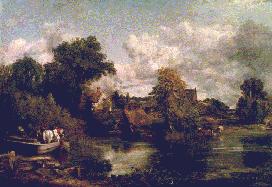The Roots of Modernism
(Plus Trees and Clouds)
John Haberin New York City
John Constable
You may have trouble thinking of picture John Constable as a revolutionary, but he was, simply by sticking to old habits. In 1797 he set out to understand the English landscape he had known from earliest childhood. That same year William Wordsworth was also walking the countryside while composing the Lyrical Ballads.
The great poet's remarkable subject matter was to determine the course of art for at least a century:
Ye mountains! thine, O nature! Thou has fed
My lofty speculations; and in thee,
For this uneasy heart of ours, I find
A never-failing principle of joy
And purest passion.
 At the end of Constable's career, his view of nature was to erupt in a comparable passion. His impasto canvases look well beyond Impressionism, to Surrealism's high-pitched unconscious.
At the end of Constable's career, his view of nature was to erupt in a comparable passion. His impasto canvases look well beyond Impressionism, to Surrealism's high-pitched unconscious.
A fascinating exhibit at the Frick tells a different story altogether. Constable, like many English artists today, was far less rebellious than I imagined, but his transformation of landscape art was even more sweeping. Part of Wordsworth's breakthrough was his diction. He aimed to restore to poetry its roots in human speech, to erase a long accretion of habit and sentiment. Constable's Romanticism may have amounted to much the same ever-patient renunciation.
The Frick brings together about 85 works on paper, all from a private collection. Although the tiny downstairs gallery does not hold up well under holiday crowds, its intimacy serves the artist overall. Expect a small show, not a major retrospective, despite the two great oil paintings in the museum's permanent holdings. Yet it is a terrific chance to assess the development of nineteenth-century art—and of our own esthetics.
Constable's life hardly sounds revolutionary. He grew up with property, the forests and locks that he depicted over many decades. Wordsworth's adoption by the political establishment was widely felt as a betrayal. Constable had always nurtured his connections to the Royal Academy, not exactly the same thing as taking a teaching job now!
His first sketches often had a finished commission in mind, like the museum's own Salisbury Cathedral. They also rely on a fine, jagged line, reflecting his immersion in print media. Soon he shifted to firm diagonal hatching, another holdover from the engraver's burin, but also influenced by Gainsborough's rapid brush. Like Gainsborough too, he looks at sheds and other human eruptions into nature. Like George Stubbs, he has one of his most famous images in a white horse.
The older artist, however, was isolating the picturesque before today's art of endangered places—and enveloping it in atmosphere. Constable's pencil diagonals treat each part of the composition equally, even dryly. The drawings look like fragments, and their seeming indifference to staged gestures and compositions was to become a new vocabulary for oil painting as well. Constable was out to explore how objects fit into a context of light and space. If it has ancestors, it announces a modernist taste not for Tiepolo, but for Vermeer, La Tour, and Saenredam.
His landscapes show another influence, again with a crucial difference. He adopted Ruysdael's low, even horizons that push right against the edge of the frame. He dispensed entirely with the Dutch painter's driving perspective and anecdotal reminders of agricultural labor. He drops how Ruysdael's trees and clouds blend together. I found it interesting that Constable's works sit so close to Rembrandt's at the Frick. Unlike the Dutch, Constable was increasingly taking each corner of the world a bit at a time, just as he found it.
The works in oil best display this stunning new vision. Color has been reduced and intensified, much like Constable's other means. In defiance of traditional atmospheric perspective, pungent greens, blues, and grays saturate the foreground, later proving quite a lesson for French Romanticism. Only a few blocks of white and red to pick out living things. Even the portraits are inordinately black.
Like the Impressionists to come, and more successfully than even Ingres or the German Romantics of the same period, Constable was using color to create tonal values. Unlike the Impressionists, he did so by juxtaposing thin washes of his preferred dark colors. He made oils on paper look almost like watercolors, a medium that was to fascinate the Pre-Raphaelites later in the century.
For J. M. W. Turner, his great contemporary, like F. E. Church in America or Caspar David Friedrich in Germany, Romanticism was born out of a struggle between realism and theater. (That current runs through another century of art, as Michael Fried and Anita Brookner have helped make clear.) It is hard to know which is most at stake when Turner has himself strapped to the mast to view a storm. Turner wanted to face nature like Ulysses amid his own siren call. The more he strove to capture weather, the more tempestuous his work became.
For Constable, theater and realism just have to look after themselves. There is first a painting to be done, literally as plain as day. When he drew a ship, it is never in motion. When he painted storm clouds, we watch dispassionately from the side. Only the incredible detail, the rapidly changing color, and the pencil notations of weather conditions remind us that Constable painted portraits of clouds as individual as dear, departing friends.
The cloud studies were for me the climax of the show and the best reason to go. I could no longer see Constable as a distant forerunner of Impressionism. He helped redefine Romanticism as the birth of a modern sensibility.

John Constable's sketches ran through February 12, 1995, at The Frick Collection. A related review looks at his painting in the Frick of Salisbury Cathedral.




